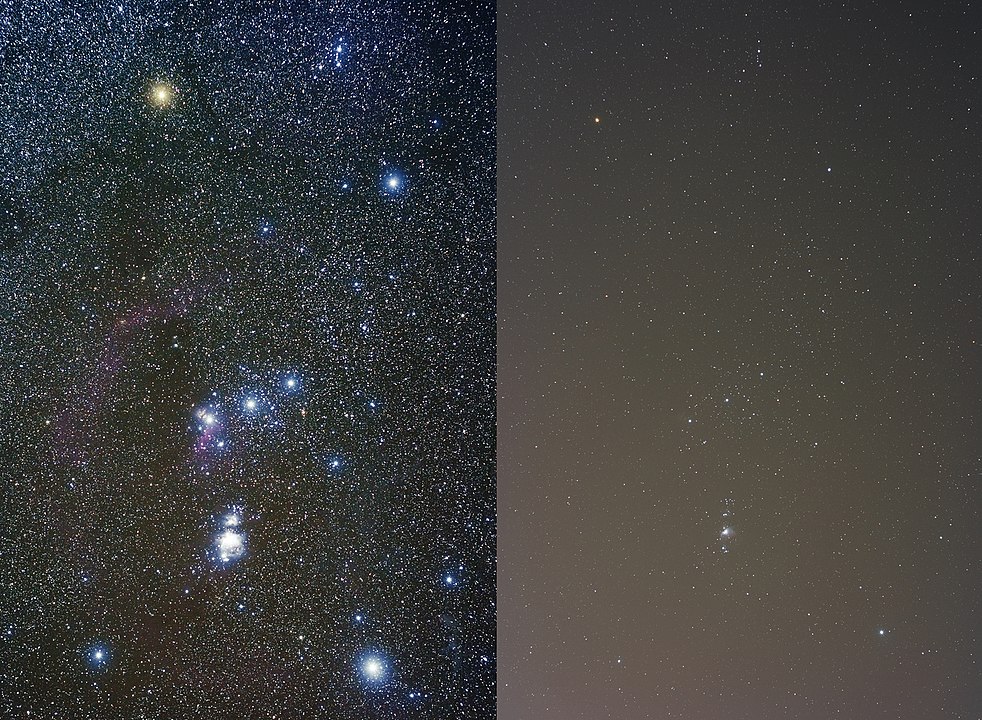Lorem ipsum dolor sit amet, consectetur adipiscing elit. Ut elit tellus, luctus nec ullamcorper mattis, pulvinar dapibus leo.
Neat to know ~ Feature of the week
Lorem ipsum dolor sit amet, consectetur adipiscing elit. Ut elit tellus, luctus nec ullamcorper mattis, pulvinar dapibus leo.
Too Much Light
the world’s vanishing night sky

The Constellation Orion, in a dark sky (left) and near the city of Orem, Utah, USA (right)
Photos: Jeremy Stanley, CC BY 2.0
2020-12-26
100 years ago, people could step outside after dusk and experience something that has become rare in today’s world: the darkness of night. On the horizon, there would be no yellowish glow emanating from an urban center. Nearby, nocturnal animals would shadow about. And above, the breathtaking vault of the sky would shimmer.
Nowadays, it’s difficult to escape light. City buildings are illuminated all night, even when no one is in them. Empty streets are bright as day at 3 AM. Parking lots and shopping malls produce a blinding glare that dilutes the darkness for miles. People’s handheld devices collectively cast a glow. Humans have turned night into a seamless continuation of day. In this way, we have disrupted the cycle of light and dark that has determined the behavior of all life on the planet for billions of years.
Scientists are studying the effects of light pollution, which are far-reaching. A night sky undiluted by artificial illumination – something humans took for granted for millennia – is now an endangered species, virtually extinct.
So, why should we care?
Animals are confused
- As they flap and soar over hundreds, even thousands, of miles, migrating birds can get disoriented by the bewildering brightness in the night sky. In addition to getting lost, they often fly into moving traffic and crash into buildings during their nightly journeys.
- Some animals, like sea turtles, navigate by moonlight. These creatures are unable to distinguish the moon’s glow from the harsh radiance of artificial lights and as a result, never reach their destinations.
- Animals that are active at night depend on the darkness. Nocturnal predators use it to catch prey, while other creatures come out at night in order to avoid predators. Some animals mate at night. Others are active after sundown to escape the heat of the day. The disappearance of darkness is having an impact on the balance of entire ecosystems.
Light is expensive
- According to the International Dark-Sky Association – one of the leading organizations in the movement to protect the night sky – the United States spends some $3.3 billion each year in excess lighting.
- But the cost is not only measured in dollars. The biggest waste comes in the form of energy. In a time when the world is increasingly unable to look away from the specter of climate catastrophe due to global warming, the U.S. is sending over 20 million tonnes of carbon dioxide into the atmosphere – just in order to power unnecessary nighttime illumination. (It would take 875 million trees to compensate for that much added CO2 in the atmosphere.) And this is just the United States. Across the globe, people are lighting up the night without regard for the consequences.
Our sleep and health are affected
- Even though we like to think that we are in complete control of everything we do, there is something called our “circadian rhythm” over which we have no conscious control. Our circadian rhythm dictates some of the underlying processes without which our bodies would not function. One such process is our sleep cycle. We sleep and are awake according to a 24-hour rotation that runs our internal clock. When we are over-exposed to bright light at night, we disrupt this cycle and damage our sleep. This can lead not only to fatigue, but to overall ill-health like headaches, anxiety, and weight-gain, as well as greater susceptibility to disease.
- Eye health is also affected by the strain of over-exposure to bright lights.
- A staggering 80% of people on earth live in areas where there is so-called “skyglow” – the washing out of the night sky by artificial illumination. 99% of people in the U.S. and Europe can no longer witness an uncontaminated night sky where they live.
What can we do about light pollution?
- There are ways to address the issue of light pollution. Each and every one of us can turn off lights – especially outdoor lights at our homes. We can also keep indoor lighting from polluting the darkness by closing our blinds. We can use bulbs that are energy-efficient.
- Communities can make immediate changes, simply by being more thoughtful about their light usage. Lighting should be directed precisely, so that it shines only where it is needed, rather than diffusing up into the sky. Lights in office buildings, parking lots, department stores, factories, etc., should be shut off at night when facilities are not in use.
- Street lights should not be unnecessarily bright. Also, they should be purposefully placed only where they are needed.
- Keep yourself informed! Be mindful of light pollution and do your part to preserve the darkness of night. Spread the word to people you know, and urge community leaders to rethink the wasteful use of light in your town. With collective willpower, we can bring back the beauty of night and preserve the darkness upon which the whole world depends.
Sources: International Dark-Sky Association, “Light Pollution,” https://www.darksky.org/light-pollution/; Dunn, Nick, The Conversation, “Cities need to embrace the darkness of the night sky – here’s why,” https://theconversation.com/cities-need-to-embrace-the-darkness-of-the-night-sky-heres-why; November 11, 2020; Globe At Night, “What is Light Pollution,” https://www.globeatnight.org/light-pollution.